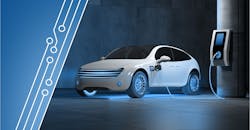This application note outlines a method of efficiently testing an E-Motor and Controller for electric vehicles. Traditional test setups require a dedicated DC source and Load in parallel to deal with bidirectional energy flow, which can require a complex test setup to coordinate energy flow and avoid damaging expensive test equipment. By employing a bidirectional DC source with a regenerative DC load one can simplify test setup, avoid catastrophic damage, and decrease test times, while also back-feeding converted energy into the grid.

